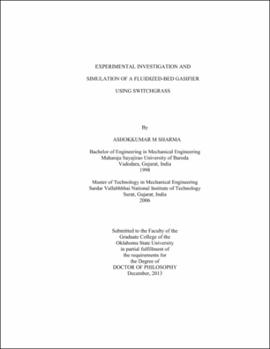| dc.description.abstract | The overall goal of this research was to improve and optimize yield and composition of syngas generated from biomass gasification using an autothermal lab-scale fluidized-bed gasifier, and to develop a biomass gasification model to predict the syngas composition. The first objective was to design, develop and experimentally optimize the equivalence ratio (ER) of a 5 kg/h lab-scale fluidized-bed gasifier using switchgrass as a biomass feedstock. The ER of 0.32 was found to be optimal with the maximum syngas heating value of 6.6 MJ/Nm3, and cold and hot gas efficiencies of 71 and 75%, respectively. Our next objective was to investigate the effects of bed-materials (i.e. a mixture of sand, switchgrass and gasifier solid residues (GSR)) on fluidization characteristics (minimum fluidization velocity and bed-pressure drop) that are critical for optimizing reaction conditions in a fluidized-bed gasifier. Results showed that the fluidization characteristics were found to be strongly dependent upon mixture's effective properties, which were determined using properties of all mixture components. GSR and switchgrass present in the mixture had a highly significant (p-value < 0.001) influence on fluidization. Then, the syngas yield was further improved by optimizing steam injection location into the gasifier. Steam injection locations of 51, 152, and 254 mm above the distributor plate and steam-to-biomass ratios (SBRs) of 0.1, 0.2, and 0.3 were selected. The best syngas yields (0.018 kg H2/kg biomass and 0.513 kg CO/kg biomass) and gasifier efficiencies (cold gas efficiency of 67%, hot gas efficiency of 72%, and carbon conversion efficiency of 96%) were obtained at the steam injection location of 254 mm and SBR of 0.2. Finally, biomass gasification models, using three modeling approaches, i.e. Gibbs equilibrium, reaction kinetics and computational fluid dynamics (CFD) with reaction kinetics, were developed and validated with experimental results. Results showed that reaction kinetics and CFD models with reaction kinetics showed considerable improvements in the prediction of syngas composition and yield, as well as gasification energy efficiency compared to the Gibbs equilibrium model. Further, the CFD model also revealed insight about distribution of syngas constituents, temperature and dominating reactions within the gasifier. | |
